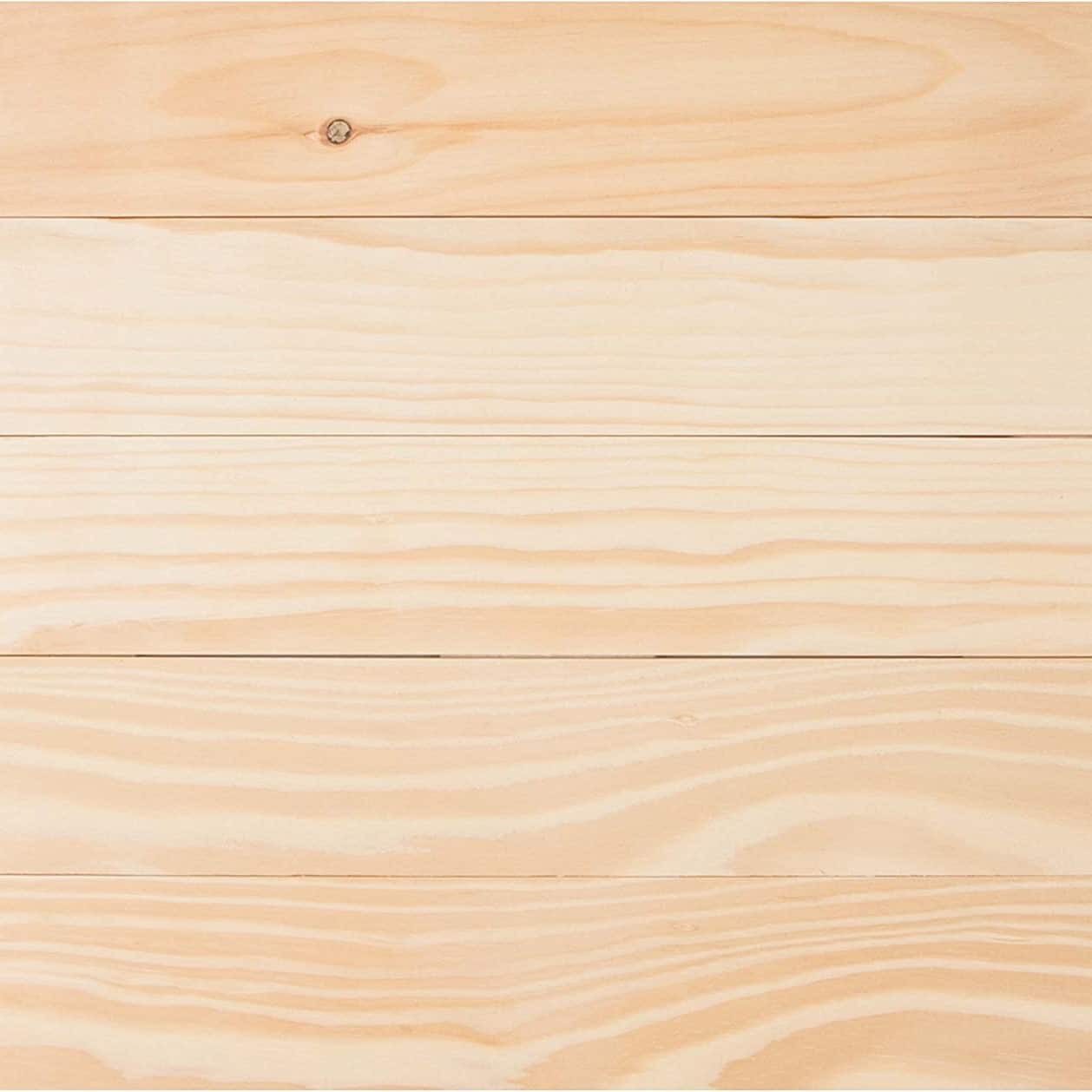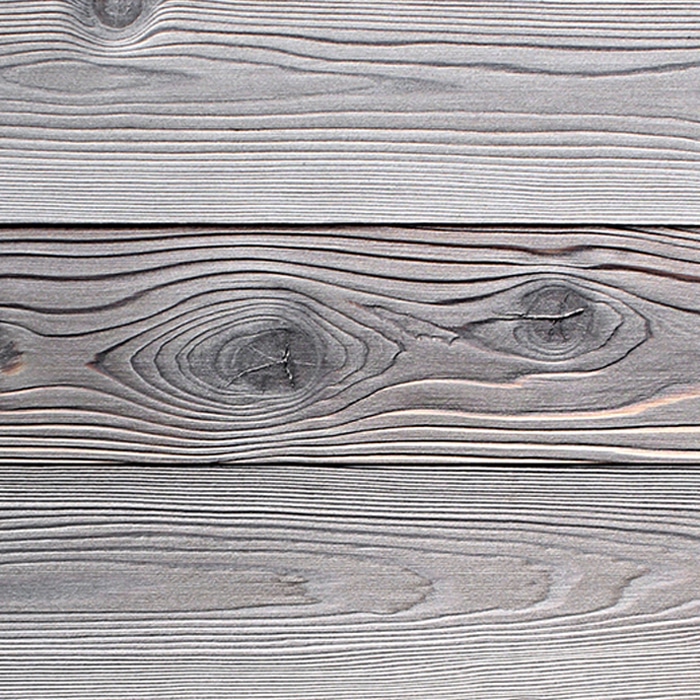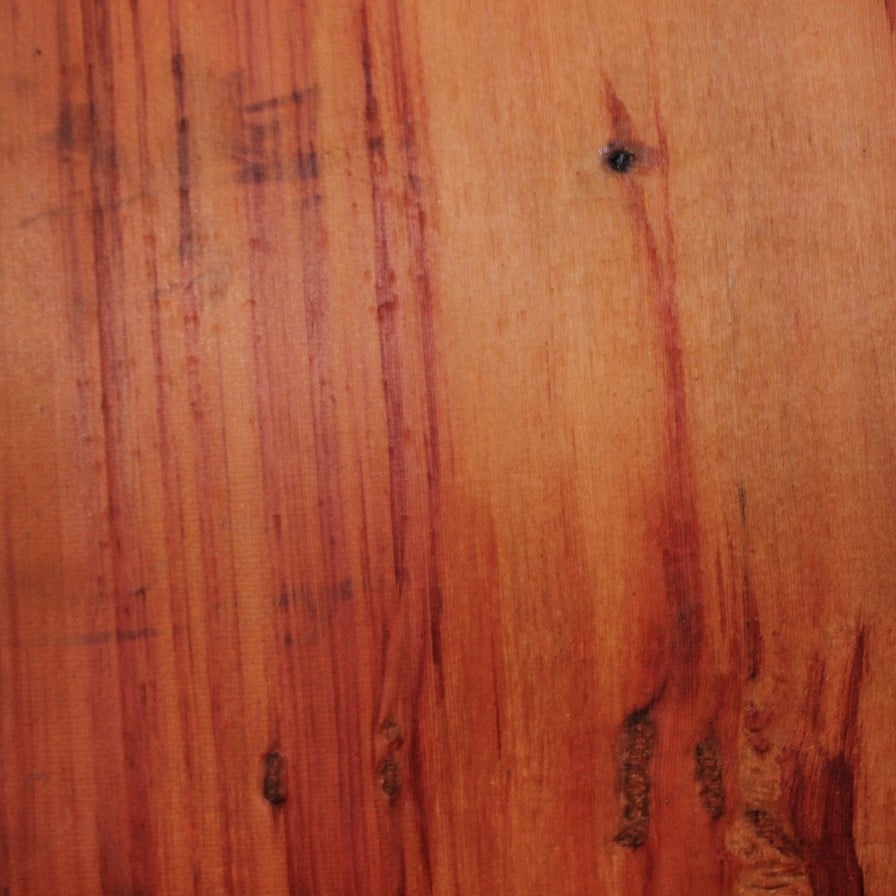If you are looking to extend your outdoor living space, one of the popular exterior additions is a deck. It is an outdoor platform or porch that can extend from a house or be detached. This is an area where you can lounge, cook, eat, and entertain outdoors, perfect for family meals, barbecue parties, and other gatherings.
Some people get decks confused with a patio, but one of the main differences is that a deck is lifted off the ground while patios are at a ground level. That’s why for homes with uneven terrain, they can still get a deck. It also provides a great view since it is usually elevated.
Another difference between the deck and patio is that patios are typically made out of concrete or stone while decks are made out of wood, aluminum, or composite materials.
If you are planning on installing a deck, one of the most important things to consider before getting a deck is its material. Besides the appearance, it is also a factor that affects the cost. To help you out, here are the different decking materials and how much they cost.
Wood
One of the most common materials for deck construction is wood. Most homeowners still prefer the look, feel, and sometimes, even the smell of real wood over plastic or metal decking. Another reason they choose wood because it remains cool even during a hot day. Wood decks retain less heat which makes them comfortable underfoot. So if you live in an area with a hot climate and get frequently exposed to the sun, it is better to get a wood deck.
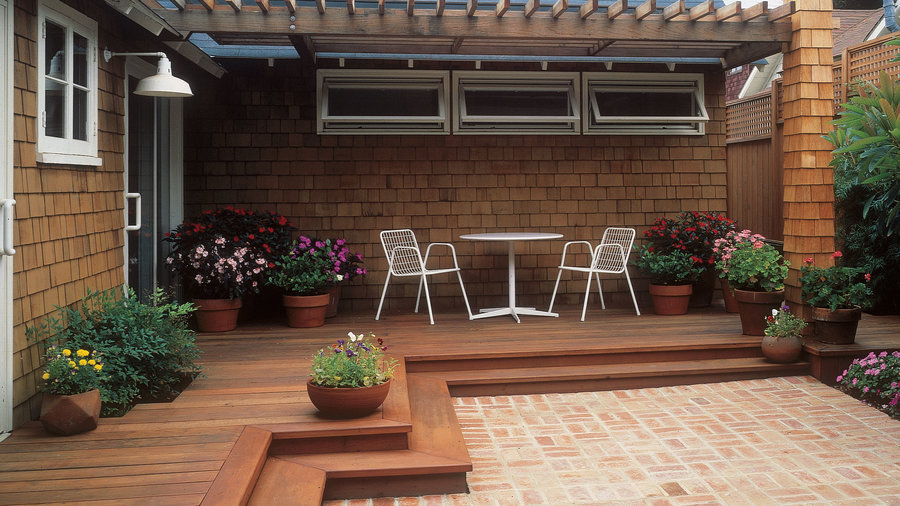
(Source: Sunset)
Compared to synthetic materials, wood is also a recyclable material. It will also be easier to clean up, if you decide to do it yourself, after installing a wood deck since the wood chips and sawdust are biodegradable.
While wood looks great, keeps cool during warm days, and is a renewable material, one of the disadvantages of getting a wood deck is that it will be harder to maintain. It requires regular maintenance since it is prone to fading, discoloration, and worst of all, rot. Wood decks also need to be stained and sealed every few years to preserve its appearance and protect it from moisture.
Now for the cost of a wood deck. With this material, you would probably spend around $1,500 to $10,000. The cost will largely depend on the size, style, and type of wood, To give you an idea of what type of wood to get, here are the pros and cons of these types as well as their cost.
Pressure-treated Wood
One of the more affordable and common materials for decks is pressure-treated wood. This material is durable and a great alternative for areas with a wet climate. It’s also rot-resistant, and when treated with chemicals, can resist mold and insects as well.
Pressure-treated wood costs around $5.30 to $7.10 per square foot. While it has a lower range, its maintenance expense includes resealing every two years. It is also prone to warp or crack over the years.
Pine
Another affordable option is pine, which is also pressure-treated. This material is durable and will eventually weathers to a beautiful shade of grey. But pine is susceptible to temperature and weather changes since it is infused with chemicals. This means it can contract or expand depending on the temperature, so you have to consider your climate before getting this material. Pine decking materials come in different grades, so the cost range is larger, around $5 to $11 per square foot.
Cedar
If you prefer a natural-looking deck with vibrant colors, cedar is a great option. It is a soft material that is easy to cut, making it an ideal material for quick deck construction. This is lighter than pine and hardwood, but it is still durable, even in different weather conditions. Cedar also produces natural oils that make it resistant to rot, decay, and moisture.
Similar to pine, it weathers to beautiful grey, but it will get splinters and cracks unless it was stained and sealed. At least it won’t warp as the years go by. Cedar costs around $4.63 to $7.70 per square foot.
Redwood
One of the most expensive materials for decking is redwood. This cost of this material can range from $5 to $35 per square foot. It is stronger and lighter than other types of wood, and naturally rot- and decay-resistant. This means it doesn’t need to be treated with preservatives, but sealing it will help preserve its natural appearance and protect it from UV. Similar to Cedar, it is a soft material that weathers to a beautiful grey. When it gets wet, it may darken, but it can be restored by washing with a mix of Clorox and water or cleaned with a pressure hose.
Wood type | Cost per Square Foot |
|---|---|
Pressure-treated wood | $5.3 to $7.10 |
Pine | $5 to $11 |
Cedar | $4.63 to $7.70 |
Redwood | $5 to $35 |
Composite
If you don’t know what composite planks are, you would probably wonder if it’s a new type of wood. Don’t worry, it is possible to think that since composite planks were designed to look and feel like wood. But don’t be fooled because they are mostly made of synthetics.
When this material was first introduced, it was made out of recycled shipping pallets and recycled milk cartons and was claimed to be rot-resistant. But it was proved otherwise and discovered that it would not rot if it was treated with a preservative. Nowadays, composite planks are now made out of cellulose fibers, virgin plastic, or a combination of these and other natural or recycled materials. But for it to be rot-resistant, it still needs to be treated with preservatives.

(Source: DDT Home Transformations)
That’s why it’s important to check if the composite materials have been treated with preservatives such as zinc borate, which can kill fungi responsible for rotting. With this material, the composite deck won’t require annual maintenance. You will just need to sweep or hose the deck with water to clean it.
You can also choose among a range of colors for your composite decking. The color of composite material lasts long, so you won’t have to worry about it fading or getting discolored quickly. If you want a unique-looking deck, you can get patterned ones or there are even some manufacturers who can do custom designs.
This material is also durable, and even after being exposed to harsh sunlight and other outdoor elements, it won’t crack, split, warp, or bulge. But when it is exposed to extreme heat, the material can become more flexible. The heat can also make it uncomfortable to lounge or walk on the deck because the material can get very hot.
Another drawback of getting a composite decking is the cost. A composite deck can cost two to five times more than wood decks. You could spend around $13,500 up to $22,000 for a composite deck. One of the reasons they are expensive is because the composite material is only used as the finish or the top of a deck. The framing and support joists are often made of wood or other materials, and there are special fasteners required. These joists should also be sturdy since composite planks are heavier than wood.
Another factor that would affect the cost is the manufacturer or brand of the composite plank. The two popular sellers in the market are Trex and DuraLife. Trex is a premium brand and its products are made out of recycled wood and plastic. Their composite planks don’t need to be painted and are slip-, insect-, and UV-resistant. To give you an idea, a Trex deck can cost around $9 to $30 per square foot.
On the other hand, DuraLife’s composite materials are made out of 60% recycled hardwood sawdust combined with polypropylene. It is scratch- stain-, and mold-resistant and has a hidden fastener system, so you won’t be seeing nail holes. Their decks are priced around $40 to $50 per 12-foot board and $55 to $60 per 16-foot planks.
While composite decking may be more expensive than wood, consider the money you will save from deck stains and pressure washers. You would spend less on maintenance, and you won’t have to worry about insects, mold, mildew, and sun damage. But to make sure that you reap the benefits of having a composite decking, the materials should be sourced from a reputable company.
Aluminum
Aluminum is one of the newer forms of materials used for decking. Aluminum decks were shortly introduced after composite plastic decks were built. It became popular with public establishments because they are more durable and last longer. Nowadays, it has become popular with homeowners and is considered as common as wood or composite decking.
Another reason for their popularity is that these are easier to maintain than composite and wood decks. You also won’t have to worry about fire safety like you will with wood, and aluminum decks can withstand different extreme temperatures. You won’t have to worry about insects, and aluminum decks won’t peel, blister or splinter.
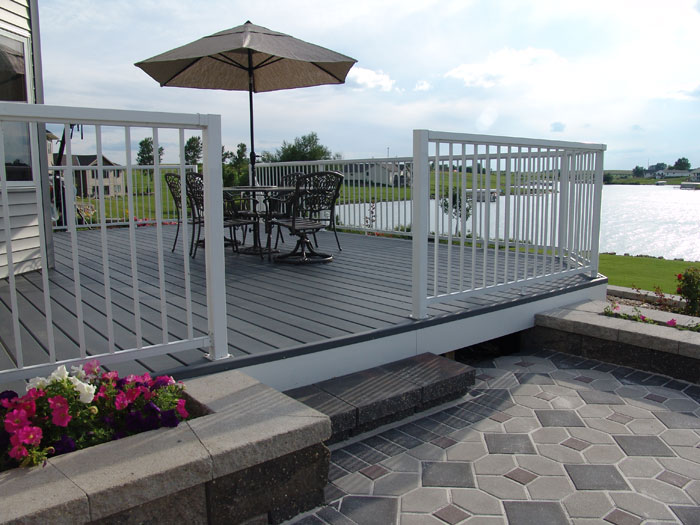
(Source: Last Deck)
Similar to composite decks, they won’t warp, break down, or deteriorate, and you can just clean them by hosing it down. Aluminum decks also won’t get or moldy. What makes aluminum decks different is that they are scratch- and scrape-resistant, while some composite decks aren’t. This means you won’t need to resurface or replace scratched or scraped boards. Aluminum planks are also lighter than composite yet more durable.
But one of its drawbacks is the aesthetics. This material comes in limited and plain colors, such as white, tan, or grey. Another is the cost of getting one. If you want an aluminum deck, you will need to expand your budget. Aluminum decks are a little bit more expensive than composite decks. It is also more difficult to source the materials and install these. Similar to composite, aluminum also needs wood for its base. The aluminum planks are just placed on top to make the deck more durable and water-resistant since it can better withstand outdoor elements.
So how much do these cost? Aluminum decks are $1 per square foot more expensive than composite decks. You would probably spend around $15,000 up to $24,000 for an aluminum deck.
Comparing Pros, Cons, and Costs
Wood
Pros
Cons
Cost
The average cost of wood ranges from $1,500 to $10,000.
Composite
Pros
Cons
Cost
The average cost of composite ranges from $13,500 to $22,000.
Aluminum
Pros
Cons
Cost
The average cost of composite ranges from $15,000 to $24,000.



